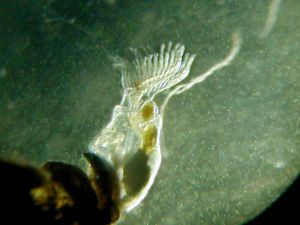Freshwater molluscs
| Freshwater molluscs | ||||||||||||
|---|---|---|---|---|---|---|---|---|---|---|---|---|

Freshwater molluscs |
||||||||||||
| Systematics | ||||||||||||
|
||||||||||||
| Scientific name of the class | ||||||||||||
| Phylactolaemata | ||||||||||||
| Allman , 1856 | ||||||||||||
| Scientific name of the order | ||||||||||||
| Plumatellida | ||||||||||||
| Pennak , 1953 |
The freshwater bryozoans form a class of bryozoans (Ectoprocta or Bryozoa), in contrast to all other classes of this animal tribe (only in fresh water limnic occurs). This class, referred to as Phylactolaemata in the systematics , comprises only one order , the Plumatellida, with five families . The Phylactolaemata are sometimes also referred to as Lophopoda.
construction
The freshwater moss can be found mostly in stagnant water, be it as a coating on stones, on the underside of sea and pond rose leaves or on branches hanging in the water. Of the more than 5000 recent species of moss animals that are known in total, only around 74 belong to the freshwater moss animals, of which 19-20 are native to Europe. The newest species discovered in Europe (Italy) are: Plumatella vaihiriae , so far only known from Tahiti , Hawaii , North America , Argentina and Thailand , and Plumatella viganoi .
The zooecia do not consist of lime as with the marine bog animals , but of chitin of various consistencies. As a result, the colonies can form gelatinous or crust-like coatings, sometimes branched forms are also found. In some species the colonies can form clumps weighing up to 1 kg. The freshwater moss animals are adapted to the change of the seasons by forming permanent stages ( statoblasts ) in autumn , which are used for wintering.
Systematics
- Class: Freshwater moss
- Order: Plumatellida
- Family: Cristatellidae
- Genus: Cristatella
- Family: Fredericellidae
- Genus: Fredericella , Internectella
- Family: Lophopodidae
- Genera: Asajirella , Lophopodella , Lophopus
- Family: Pectinatellidae
- Genera: Pectinatella
- Family: Plumatellidae
- Genera: Afrindella , Australella , Gelatinella , Hyalinella , Plumatella , Stolella , Swarupella , Varunella
- Family: Stephanellidae
- Genus: Stephanella
- Family: Cristatellidae
- Order: Plumatellida
literature
- Geimer, G. & JA Massard (1986): Les Bryozoaires du Grand-Duché de Luxembourg et des régions limitrophes. (PDF; 9.5 MB) Travaux Scientifiques du Musée d'Histoire Naturelle de Luxembourg, 7: 1–187.
- Lacourt, AW (1968): A Monograph of the Freshwater Bryozoa: Phylactolaemata. Zoological Negotiations, 93: 1–159.
- Massard, JA & G. Geimer (2008): Global Diversity of Bryozoans (Bryozoa or Ectoprocta) in Freshwater: An Update. (PDF file; 256 kB) Bulletin de la Société des Naturalistes luxembourgeois, 109: 139–148.
- Wesenberg-Lund, C. (1939): Biology of freshwater animals. Invertebrates. Wien, J. Springer, 817 p. (Reprint 1982, Vlg. J. Cramer, Braunschweig and Vlg. O. Koeltz, Koenigstein). (Bryozoa: 369-394).
- Wiebach, F. (1960): Bryozoa . In: P. Brohmer et al. (Ed.): Die Tierwelt Mitteleuropas, 1 (8), Leipzig: 1–56, Tfl. 1-19.
- Wood, TS & B. Okamura (2005): A New Key to the Freshwater Bryozoans of Britain, Ireland and Continental Europe, with Notes on Their Ecology. Freshwater Biological Association Scientific Publication, 63: 1-113.
- Wöss, E. (2005): Moostiere (Bryozoa). Denisia 16: 1–369 (catalogs of the Upper Austrian regional museums, NS 28).
Individual evidence
-
Jump up ↑ Taticchi, MI, G. Pieroni & AC Elia (2008): First finding of Plumatella vaihiriae (Hastings, 1929) (Bryozoa, Phylactolaemata) in Europe . Italian Journal of Zoology, 75 (4): 411-416 (not included in Massard & Geimer 2008).
Taticchi, MI (2010): Plumatella viganoi, a new freshwater bryozoan species (Phylactolaemata) from Lake Trasimeno (Umbria, Italy). Italian Journal of Zoology, 77 (3): 316-322. - ↑ See: M. Hirose, MH Dick & SF Matawari: Molecular Phylogenetic Analysis of Phylactolaemate Bryozoans Based on Mitochondrial Gene Sequences . In: Bryozoan Studies 2007 (Eds. By SJ Hageman, MM Key, JE Winston). Virginia Museum of Natural History Special Publication Number 15, Martinsville, Virginia 2008: 65-74. See also: Massard & Geimer 2008, p. 140 f, tab. 1, note g. (PDF; 256 kB)